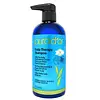What's inside
What's inside
 Key Ingredients
Key Ingredients

 Benefits
Benefits

 Concerns
Concerns

 Ingredients Side-by-side
Ingredients Side-by-side

Water
Skin ConditioningGlycerin
HumectantSodium Lauroyl Methyl Isethionate
CleansingSodium Cocoyl Isethionate
CleansingSodium Laurylglucosides Hydroxypropylsulfonate
CleansingPyrus Malus Fruit Extract
Skin ConditioningCaprylyl Glycol
EmollientCoco-Glucoside
CleansingGlyceryl Oleate
EmollientGuar Hydroxypropyltrimonium Chloride
Skin ConditioningCitric Acid
BufferingSodium Benzoate
MaskingDipotassium Glycyrrhizate
HumectantCaprylhydroxamic Acid
Panthenol
Skin ConditioningSodium Phytate
Aloe Barbadensis Leaf Juice
Skin ConditioningAvena Sativa Kernel Extract
AbrasiveHyaluronic Acid
HumectantPotassium Sorbate
PreservativeSodium Hydroxide
BufferingWater, Glycerin, Sodium Lauroyl Methyl Isethionate, Sodium Cocoyl Isethionate, Sodium Laurylglucosides Hydroxypropylsulfonate, Pyrus Malus Fruit Extract, Caprylyl Glycol, Coco-Glucoside, Glyceryl Oleate, Guar Hydroxypropyltrimonium Chloride, Citric Acid, Sodium Benzoate, Dipotassium Glycyrrhizate, Caprylhydroxamic Acid, Panthenol, Sodium Phytate, Aloe Barbadensis Leaf Juice, Avena Sativa Kernel Extract, Hyaluronic Acid, Potassium Sorbate, Sodium Hydroxide
Aloe Barbadensis Leaf Juice
Skin ConditioningCetyl Hydroxyethylcellulose
Emulsion StabilisingSodium Hydroxide
BufferingKeratin
Skin ConditioningSodium Cocoyl Glutamate
CleansingCocamidopropyl Hydroxysultaine
CleansingPolysorbate 20
EmulsifyingBiotin
AntiseborrhoeicPolyquaternium-73
Cocamide Mipa
EmulsifyingArgania Spinosa Kernel Oil
EmollientMelaleuca Alternifolia Leaf Oil
AntioxidantMentha Piperita Oil
MaskingCitrus Limon Peel Oil
MaskingCedrus Atlantica Bark Oil
MaskingLavandula Angustifolia Oil
MaskingSalvia Sclarea Oil
MaskingPersea Gratissima Oil
Skin ConditioningPogostemon Cablin Leaf Oil
MaskingIsobutylamido Thiazolyl Resorcinol
BleachingRiboflavin
Cosmetic ColorantNiacin
SmoothingPantothenic Acid
Skin ConditioningPyridoxine
Skin ConditioningFolic Acid
Skin ConditioningCyanocobalamin
Skin ConditioningAscorbic Acid
AntioxidantZinc Gluconate
Skin ConditioningTocopherol
AntioxidantCaprylhydroxamic Acid
Caprylyl Glycol
EmollientGlycerin
HumectantCitric Acid
BufferingAloe Barbadensis Leaf Juice, Cetyl Hydroxyethylcellulose, Sodium Hydroxide, Keratin, Sodium Cocoyl Glutamate, Cocamidopropyl Hydroxysultaine, Polysorbate 20, Biotin, Polyquaternium-73, Cocamide Mipa, Argania Spinosa Kernel Oil, Melaleuca Alternifolia Leaf Oil, Mentha Piperita Oil, Citrus Limon Peel Oil, Cedrus Atlantica Bark Oil, Lavandula Angustifolia Oil, Salvia Sclarea Oil, Persea Gratissima Oil, Pogostemon Cablin Leaf Oil, Isobutylamido Thiazolyl Resorcinol, Riboflavin, Niacin, Pantothenic Acid, Pyridoxine, Folic Acid, Cyanocobalamin, Ascorbic Acid, Zinc Gluconate, Tocopherol, Caprylhydroxamic Acid, Caprylyl Glycol, Glycerin, Citric Acid
Alternatives
Ingredients Explained
These ingredients are found in both products.
Ingredients higher up in an ingredient list are typically present in a larger amount.
Aloe Barbadensis Leaf Juice comes from leaves of the aloe plant. Aloe Barbadensis Leaf Juice is best known for helping to soothe sunburns. It is also anti-inflammatory, moisturizing, antiseptic, and can help heal wounds.
Aloe is packed with good stuff including Vitamins A, C, and E. These vitamins are antioxidants, which help fight free-radicals and the damage they may cause. Free-radicals are molecules that may damage your skin cells, such as pollution.
Aloe Barbadensis Leaf Juice also contains sugars. These sugars come in the form of monosaccharides and polysaccharides, folic acid, and choline. These sugars are able to help bind moisture to skin.
It also contains minerals such as calcium, 12 anthraquinones, fatty acids, amino acids, and Vitamin B12.
Learn more about Aloe Barbadensis Leaf JuiceCaprylhydroxamic Acid is a chelating agent.
Chelating agents help prevent metal ions from binding to other ingredients. This helps prevent unwanted reactions and effects from using the product.
Caprylhydroxamic Acid is often used with natural antimicrobial products as an alternative to preservatives.
Learn more about Caprylhydroxamic AcidCaprylyl Glycol is a humectant and emollient, meaning it attracts and preserves moisture.
It is a common ingredient in many products, especially those designed to hydrate skin. The primary benefits are retaining moisture, skin softening, and promoting a healthy skin barrier.
Though Caprylyl Glycol is an alcohol derived from fatty acids, it is not the kind that can dry out skin.
This ingredient is also used as a preservative to extend the life of products. It has slight antimicrobial properties.
Learn more about Caprylyl GlycolCitric Acid is an alpha hydroxy acid (AHA) naturally found in citrus fruits like oranges, lemons, and limes.
Like other AHAs, citric acid can exfoliate skin by breaking down the bonds that hold dead skin cells together. This helps reveal smoother and brighter skin underneath.
However, this exfoliating effect only happens at high concentrations (20%) which can be hard to find in cosmetic products.
Due to this, citric acid is usually included in small amounts as a pH adjuster. This helps keep products slightly more acidic and compatible with skin's natural pH.
In skincare formulas, citric acid can:
While it can provide some skin benefits, research shows lactic acid and glycolic acid are generally more effective and less irritating exfoliants.
Most citric acid used in skincare today is made by fermenting sugars (usually from molasses). This synthetic version is identical to the natural citrus form but easier to stabilize and use in formulations.
Read more about some other popular AHA's here:
Learn more about Citric AcidGlycerin is already naturally found in your skin. It helps moisturize and protect your skin.
A study from 2016 found glycerin to be more effective as a humectant than AHAs and hyaluronic acid.
As a humectant, it helps the skin stay hydrated by pulling moisture to your skin. The low molecular weight of glycerin allows it to pull moisture into the deeper layers of your skin.
Hydrated skin improves your skin barrier; Your skin barrier helps protect against irritants and bacteria.
Glycerin has also been found to have antimicrobial and antiviral properties. Due to these properties, glycerin is often used in wound and burn treatments.
In cosmetics, glycerin is usually derived from plants such as soybean or palm. However, it can also be sourced from animals, such as tallow or animal fat.
This ingredient is organic, colorless, odorless, and non-toxic.
Glycerin is the name for this ingredient in American English. British English uses Glycerol/Glycerine.
Learn more about GlycerinSodium Hydroxide is also known as lye or caustic soda. It is used to adjust the pH of products; many ingredients require a specific pH to be effective.
In small amounts, sodium hydroxide is considered safe to use. However, large amounts may cause chemical burns due to its high alkaline.
Your skin has a natural pH and acid mantle. This acid mantle helps prevent harmful bacteria from breaking through. The acid mantle also helps keep your skin hydrated.
"Alkaline" refers to a high pH level. A low pH level would be considered acidic.
Learn more about Sodium Hydroxide